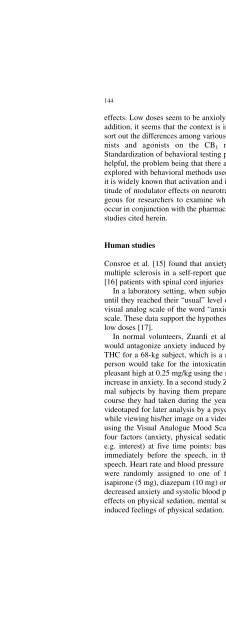3. Umbruch 4.4..2005 - Online Pot
3. Umbruch 4.4..2005 - Online Pot
3. Umbruch 4.4..2005 - Online Pot
You also want an ePaper? Increase the reach of your titles
YUMPU automatically turns print PDFs into web optimized ePapers that Google loves.
144 R.E. Musty<br />
effects. Low doses seem to be anxiolytic, while high doses are anxiogenic. In<br />
addition, it seems that the context is important. Further research is needed to<br />
sort out the differences among various studies, but it is clear that both antagonists<br />
and agonists on the CB 1 receptor have anxiolytic properties.<br />
Standardization of behavioral testing procedures across laboratories would be<br />
helpful, the problem being that there are many variables which have not been<br />
explored with behavioral methods used to test for anxiolytic properties. Since<br />
it is widely known that activation and inactivation of CB 1 receptors has a multitude<br />
of modulator effects on neurotransmitter systems, it would be advantageous<br />
for researchers to examine what changes in neurotransmitter activity<br />
occur in conjunction with the pharmacological effects observed in the types of<br />
studies cited herein.<br />
Human studies<br />
Consroe et al. [15] found that anxiety was reduced in 85% of patients with<br />
multiple sclerosis in a self-report questionnaire. In another self-report study<br />
[16] patients with spinal cord injuries reported similar reductions in anxiety.<br />
In a laboratory setting, when subjects were instructed to smoke marijuana<br />
until they reached their “usual” level of intoxication, regression analysis of a<br />
visual analog scale of the word “anxious” predicted decreased scores on this<br />
scale. These data support the hypothesis that THC has anxiolytic properties at<br />
low doses [17].<br />
In normal volunteers, Zuardi et al. [18] tested the hypothesis that CBD<br />
would antagonize anxiety induced by THC. They used a dose of 0.5 mg/kg<br />
THC for a 68-kg subject, which is a rather large dose, exceeding the dose a<br />
person would take for the intoxicating effect of the drug. Subjects report a<br />
pleasant high at 0.25 mg/kg using the same route of administration without an<br />
increase in anxiety. In a second study Zuardi et al. [19] induced anxiety in normal<br />
subjects by having them prepare a 4-min speech about a topic from a<br />
course they had taken during the year. They were told the speech would be<br />
videotaped for later analysis by a psychologist. The subject began the speech<br />
while viewing his/her image on a video monitor. Anxiety measures were taken<br />
using the Visual Analogue Mood Scale (VAMS), which yields measures on<br />
four factors (anxiety, physical sedation, mental sedation and other feelings,<br />
e.g. interest) at five time points: baseline, immediately before instructions,<br />
immediately before the speech, in the middle of the speech and after the<br />
speech. Heart rate and blood pressure measures were also taken. The subjects<br />
were randomly assigned to one of four drug conditions: CBD (300 mg),<br />
isapirone (5 mg), diazepam (10 mg) or placebo. CBD, diazepam and isapirone<br />
decreased anxiety and systolic blood pressure. Neither CBD nor isapirone had<br />
effects on physical sedation, mental sedation, or other feelings, but diazepam<br />
induced feelings of physical sedation.







